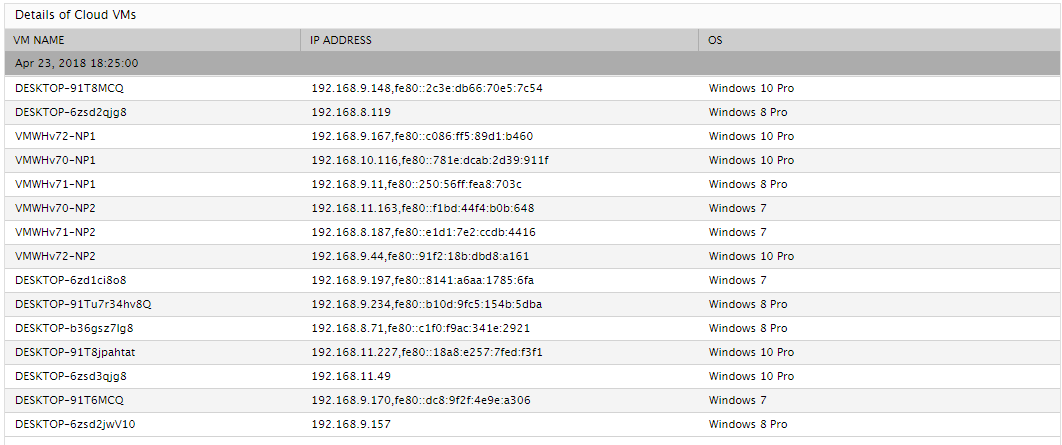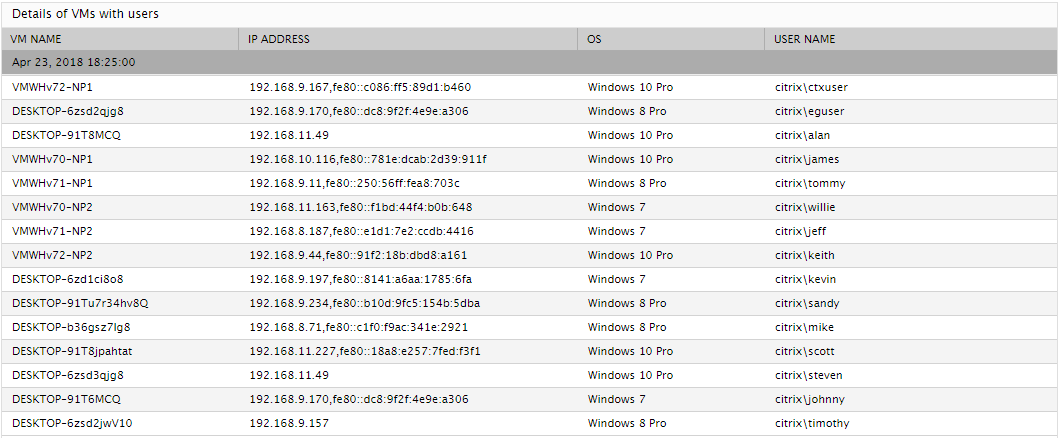Virtual Machines - Cloud Test
This test reports the number and names of Windows virtual desktops (on the cloud) for which the VM agents reported metrics during the last hour. Additionally, the test also reveals those VMs that are currently powered-on, and those VMs that have users logged into them presently. This way, administrators can quickly identify the powered-off VMs and those that are not in use currently.
Target of the test : A Windows virtual desktop on the cloud
Agent deploying the test : A remote agent
Outputs of the test : One set of results for the 'Cloud Desktops' component being monitored
| Parameter | Description |
|---|---|
|
Test Period |
How often should the test be executed. |
|
Host |
The nick name of the Cloud Desktops component for which this test is to be configured. |
|
Port |
Refers to the port at which the specified host listens to. By default, this is NULL. |
|
Inside View Using |
To obtain the 'inside view' of performance of the cloud-hosted Windows desktops - i.e., to measure the internal performance of the Windows virtual desktops - this test uses a light-weight eG VM Agent software deployed on each of the desktops. Accordingly, this parameter is by default set to eG VM Agent (Windows). |
|
Report Powered OS |
This flag is relevant only for those tests that are mapped to the Inside View of Desktops layer. If this flag is set to Yes (which is the default setting), then the 'inside view' tests will report measures for even those Windows virtual desktops that do not have any users logged in currently. Such desktops will be identified by their name and not by the username_on_virtualdesktopname. On the other hand, if this flag is set to No, then this test will not report measures for those Windows virtual desktops to which no users are logged in currently. |
|
Is Cloud VMs |
Since this test runs for a 'Cloud Desktops' component, this flag is set to Yes by default. |
|
DD Frequency |
Refers to the frequency with which detailed diagnosis measures are to be generated for this test. For instance, if you set to 1:1, it means that detailed measures will be generated every time this test runs, and also every time the test detects a problem. |
|
Detailed Diagnosis |
To make diagnosis more efficient and accurate, the eG suite embeds an optional detailed diagnostic capability. With this capability, the eG agents can be configured to run detailed, more elaborate tests as and when specific problems are detected. To enable the detailed diagnosis capability of this test for a particular server, choose the On option. To disable the capability, click on the Off option. The option to selectively enable/disable the detailed diagnosis capability will be available only if the following conditions are fulfilled:
|
| Measurement | Description | Measurement Unit | Interpretation |
|---|---|---|---|
|
Total VMs reported in the last one hour |
Indicates the number of Windows virtual desktops (on the cloud) that reported metrics during the last hour. |
Number |
To know which virtual desktops reported metrics, use the detailed diagnosis of this measure. |
|
Currently powered on VMs |
Indicates the number of VMs that are powered-on currently. |
Number |
If the value of this measure is the same as that of the Total VMs reported in the last one hour measure, it means that all Windows virtual desktops are presently in a powered-on state. On the other hand, if the value of this measure is lesser than the value of the Total VMs reported in the last one hour measure, it implies that some virtual desktops are powered-off currently. The value 0 for this measure indicates that none of the VMs that reported in the last hour are powered-on currently. |
|
VMs with users |
Indicates the number of Windows virtual desktops to which users are currently logged in. |
Number |
Use the detailed diagnosis of this measure to know to which virtual desktops users have logged in currently. |
|
VMs without users |
Indicates the number of Windows virtual desktops to which no user is currently logged in. |
Number |
Use the detailed diagnosis of this measure to know to which virtual desktops no user is presently logged in. |
Using the detailed diagnosis of the Total VMs reported in the last hour measure to you can learn the name, IP address, and the OS of the reporting VMs.

Figure 2 : The detailed diagnosis of the Total VMs reported in the last hour measure
Use the detailed diagnosis of the VMs with users measure to know which Windows virtual desktops (on the cloud) have users logged in currently and the name of the user who is logged in.

Figure 3 : The detailed diagnosis of the VMs with users measure
